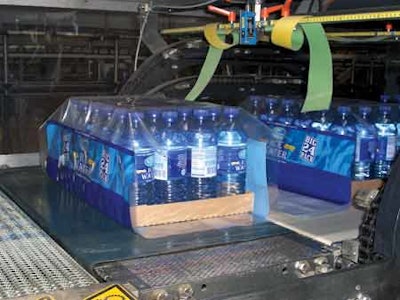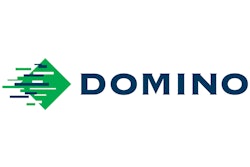With 550ꯠ sq' of floor space—350ꯠ sq' of it occupied by package making and packaging—the new Phoenix plant built by Le-Nature's Inc. is just what this Latrobe, PA-based beverage firm needed to break into western markets in a big way.
“Shipments to the western U.S. were greatly limited until now,” says chief operating officer Jonathan Podlucky. “The Phoenix plant will change that.”
The investment in packaging-related equipment at Phoenix is impressive:
• seven blow-molding machines churning out PET bottles in sizes from 8-oz to 1-L
• five injection-molding machines for in-house manufacturing of PET preforms
• four PET bottling lines handling Le-Nature's assortment of flavored or enhanced waters, sports drinks, fitness waters, teas, juices, and other New Age beverages
A good feel for the way things run at the Phoenix plant can be gained by looking at Line 3. Used primarily for water, it can also run carbonated soft drinks. It handles 24-oz, 1⁄2-L, and 1-L bottles.
At the head of the line are two Contiform stretch/blow-molding machines—one a 16-station system and the other 24—supplied by Krones (www.krones.de). That firm was charged with turnkey responsibility for blow molding and packaging, and a whole lot of Krones equipment is seen throughout Le-Nature's packaging hall.
“In a greenfield plant like this, we needed a machinery supplier vertically integrated enough to capably handle a huge project,” says Podlucky. “We felt Krones was that company, and we've been very pleased with the results. Naturally, there were bumps along the way. But I've been involved in much smaller projects that didn't go nearly as smoothly as this one.”
Racking system
Upstream from the blow molders is the massive gravity-feed racking system used to feed not only the two blow molders in Line 3 but the five other Krones blow molders dedicated to other lines. Corrugated gaylords are filled by a bank of five 128-cavity injection-molding systems from Husky (www.husky.ca), each with a 300-ton clamp force. Gaylords filled with performs are fed into the racking system, which is gently sloped so that the gaylords can roll down as needed in the direction of the blow-molding machines at the opposite side. A fork lift operator empties gaylords of preforms into hoppers that feed the blow-molding machines.
Back to Line 3. It includes a silo into which bottles from either blow molder can be diverted if any downstream machines go down. “That way,” says production manager James Stark, “we don't have to shut down the blow molders if there's a momentary pause in the bottling line.”
Air conveyors carry bottles away from the blow-molding area along three tracks: one for each blow molder and one for the silo. An automated gating system with pneumatics from Festo (www.vacuumbarrier.com). The nitrogen goes from liquid to gaseous states to form a slight internal pressure that prevents the lightweight bottle's sidewalls from collapsing.
“This is new to us with the Phoenix plant,” says Podlucky. “It lets us lightweight the bottle slightly.”
Sitting outside the rinser/filler/capper is an Aidlin cap sorter from Sidel (www.sidel.com) that feeds caps to the capper. Exiting the rinser/filler/capper block, a Krones Checkmat system checks for cocked caps, low fills, and damaged caps. Then it's on to a Krones Canmatic cold glue labeler.
Polypropylene film labels are supplied by Graphic Packaging (www.graphicpkg.com). The operator who feeds the label magazine first puts stacks of labels in a tabletop device that vibrates rapidly to ensure no two labels are stuck together. Stuck labels would not be a good thing when the labeler runs at 330 bottles/min.
Laser date coder
As they leave the labeler, bottles are conveyed past a laser date coder supplied by Domino Amjet (www.dominoamjet.com). Bottles next follow one of two paths. If production calls for 24 loose bottles in a tray, bottles move directly into a Krones Variopack tray packer/shrink wrapper that applies printed film in register. Bottles can also be sent through two Variopack machines, the first for shrink bundling into four-, six-, or 12-packs and the second for traypacking the shrink-wrapped bundles.
“When we do shrink-wrapped bundles in a tray, the shrink film over the tray is clear,” says Stark. “So we have a thermal-transfer coder on the line to print and apply a bar code to the clear film.”
Palletizing on a Krones palletizer and stretch wrapping of pallets on a Robopac (www.robopac.com) stretch wrapper are all that remain. Just seven operators are required to man the line, including one forklift driver who empties preforms into hoppers feeding the blow molders.
Podlucky says the part about Line 3 that impresses him the most is its blow/fill capabilities. Back in Latrobe, Le-Nature's also makes its own preforms and blows its own bottles. But blown bottles are stored in silos before being brought to the filling lines.
“Any time you can reduce the amount of space consumed by storage requirements the way in-line blow/fill has done at Phoenix, it's an accomplishment,” says Podlucky.
Aseptic plans
He also adds that Le-Nature's is planning to add aseptic filling to its portfolio of operations at the Phoenix plant, something it currently doesn't practice. Both high- and low-acid products will be in the mix.
The upfront capital investment required for aseptic filling of plastic bottles has been a barrier to entry, notes Podlucky. “But some of the people we're working with have found ways to reduce that cost without sacrificing speed or quality,” he adds. “Aseptic filling of juices and teas that are currently pasteurized in the bottle would let us lightweight the bottles.”
As with everything else at the new Phoenix plant, Le-Nature's plan to get into aseptic filling is all about one thing. “We want to grow the business,” says Podlucky.






































